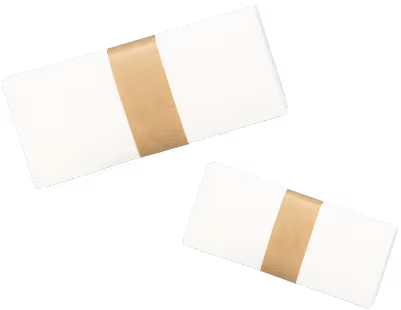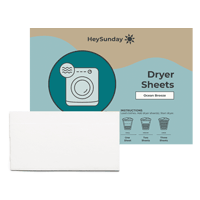
Is Your Laundry Detergent Causing a Rash? 4 Ingredients that May Be to Blame
Between harsh chemicals and near industrial-strength preservatives, finding a laundry detergent that keeps your clothes clean without causing a dreaded laundry detergent rash can seem impossible.
With the right understanding of what causes this condition in the first place, however, you can know exactly what to look for when shopping for detergents (or detergent sheets!). Below, we'll talk about the two main conditions behind laundry detergent rashes, which ingredients are most likely to trigger them, and why HeySunday is one of your best options for skin-safe, effective detergent sheets.
What Causes a Laundry Detergent Rash
One of the most challenging factors of detergent rashes is that they may be triggered by any number of chemicals and ingredients. Still, the reaction itself more or less comes down to two specific conditions: allergic contact dermatitis and irritant contact dermatitis. While these conditions may seem similar at first, there are some key differences that can help you determine which one you're experiencing.
Allergic Contact Dermatitis
When most people think of detergent rashes, "allergic reaction" is typically one of the first phrases to come to mind. Ironically, true laundry detergent allergies are rare, with studies indicating that less than 1% of people experience these kinds of allergic reactions.
For that 1%, however, these reactions can be frustrating, painful, and even worsen with continued exposure. Like most allergic reactions, a detergent allergy happens when your immune system "overreacts" to a chemical or other ingredient in your laundry detergent of choice. When this happens, your body produces antibodies in an attempt to destroy the offending substance, which also causes the hallmark symptoms of an allergic reaction in the process.
Because laundry detergent contact is almost always fabric-to-skin, this results in what is known as allergic contact dermatitis. This condition, which accounts for roughly 20% of all cases of contact dermatitis from all sources, can present with symptoms such as:
- A scaly or itchy rash with ill-defined borders
- Skin irritation, including inflammation or a burning sensation
- Cracked or flaking skin
- Bumps or small blisters (vesicles)
Unlike irritant contact dermatitis, which often appears suddenly, allergic contact dermatitis usually worsens gradually over time and requires "sensitization," or an initial exposure to the substance, before future reactions can occur.
Irritant Contact Dermatitis
Among all types of contact dermatitis, the irritant subtype is by far the most common, accounting for almost 80% of all cases. Compared to allergic contact dermatitis, which occurs due to the immune system's natural reaction to an allergen, irritant contact dermatitis happens when abrasive or harsh chemicals damage the skin, resulting in dreaded laundry detergent rashes for those with more sensitive skin.
Though at first glance, this can seem identical to an allergic reaction to laundry detergent, irritant contact dermatitis develops in certain ways that you can use to tell the two reactions apart.
One of the most important differences with irritant contact dermatitis is its tendency to occur suddenly or acutely, with symptoms reaching a "crescendo" and then slowly improving. This is almost exactly the opposite of allergic contact dermatitis, which often starts gradually and then worsens with each repeated exposure after the first.
Other common symptoms of irritant contact dermatitis include:
- Burning or stinging rash with clear borders
- Shiny or thickened skin
- Sudden appearance during first exposure
The 4 Ingredients to Look Out for in Laundry Detergents
For individuals experiencing a true laundry detergent allergy, attacks can be triggered by almost any ingredient possible, depending on your circumstances. Still, there are certain chemicals that some laundry detergents typically use that may cause more adverse skin reactions than others—both allergic or irritant in nature.
Phthalates
Phthalates are chemicals that have seen use in everything from vinyl flooring to heavy-duty solvents and are also used by many traditional laundry detergents to extend the lifespan of artificial fragrances or change a liquid's consistency into that familiar blue goop.
Unfortunately, recent studies have begun to link phthalates to a number of concerning side effects, even beyond the skin rashes that many experience. Specifically, these studies have shown that phthalates may interfere with the body's hormone production, potentially affecting things like fertility, fetal development, or other reproductive functions.
As this research continues, more and more detergent companies are opting to remove phthalates from their products entirely, but always do your research to make sure that your detergent of choice is free of these chemicals. For those with more sensitive skin, consider trying a fragrance-free product as well.
Dyes
Regardless of whether they're more traditional, natural dyes or their modern, synthetic alternatives, dyes have long been recognized as a potential trigger for allergic contact dermatitis. This link is so well-known, in fact, that a group of dyes known as "disperse blue dyes" was recognized as the 2000 Allergen of the Year by the American Contact Dermatitis Society.
Previously, many big-name detergents used other blue dyes as a way to make whites appear whiter after washing, but most companies (detergent sheet brands, in particular) are transitioning to dye-free alternatives in the 21st century.
Fabric Softeners
The only thing better than freshly washed clothes is ultra-soft, freshly washed clothes, which is why fabric softeners reigned for decades as one of the most popular laundry room staples. As science advanced and our understanding of the chemicals behind fabric softeners increased, however, experts quickly began warning against one ingredient in particular: quaternary ammonium compounds.
More commonly known as "quats," these chemicals are crucial for many detergents' fabric softening abilities and also work as antibacterial agents.
That said, modern studies have linked repeated exposure to quats to both contact dermatitis and asthma-related issues, as well as concerning environmental effects. While these studies mostly surveyed cleaning professionals who interacted with cleaning agents daily, they have still raised concerns about the usage of the chemicals in laundry detergents in general.
Phosphates
Historically used as one of the most common water softeners in detergent formulas, phosphates have recently come under fire for a range of potential health concerns, from skin irritations and nausea to environmental damage.
Today, usage of this ingredient is primarily limited to "heavy-duty" detergents, but always check the formula of your chosen detergent brand before using it on your clothes and fabrics.
Keep in mind, however, that a good phosphate-free detergent should still work well in both hard and soft water. While you may think you need to sacrifice some cleaning power for full skin safety, that couldn't be further from the truth: there are plenty of plant-based ingredients that can help soften water and keep your clothes looking as good as new.
How to Prevent Laundry Detergent Rash with HeySunday Detergent Sheets
When most people start shopping for eco-friendly or skin-safe laundry detergents, they expect that they'll have to lose some cleaning power when switching over. While that may be true for some detergents, modern science has opened the door to a powerful new arsenal of plant-based ingredients that clean as well or better than traditional detergents. Even better, they do so without the same risk of irritating your skin with harsh chemicals and unwanted additives.
To that end, HeySunday designed its detergent sheets to combine the best of both worlds, all backed by a risk-free guarantee that we’ll live up to our promises. With seven powerful plant-based surfactants, zero phthalates, phosphates, dyes, or "quats," one use of HeySunday detergent sheets will show you why they deserve a spot on your laundry room shelf.














“My sheets have never felt cleaner. I’m hooked.”
“Finally — detergent that actually works and doesn’t take up half the shelf.”
“Hey Sunday WORKS. Great for stains, and no buildup in the washer.”
“We switched from liquid. The scent is amazing and it saves us money.”
“I’ve got total control with HeySunday. I’ll never go back to powder.”